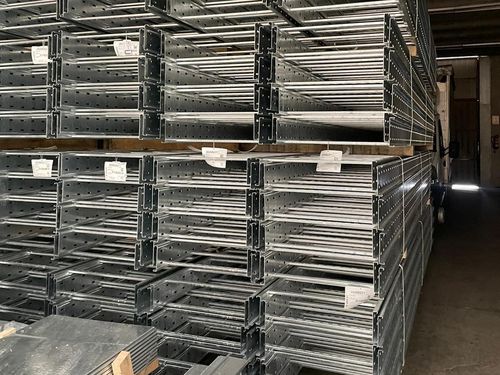We rarely stop to think about the process behind their manufacture, but creating these parts requires a high level of precision and the use of specialised technology. Each stage is key to ensuring a strong, high quality product, capable of adapting to the needs of any project. Below, we detail all the stages of the process.
1. Environmental analysis, design and planning:
It all starts with a detailed study of the environment and the specific needs of the installation. This stage is essential to anticipate any challenges and ensure that everything fits together. The cross-section of the cables to be carried per tray and the characteristics of the environment will be the guidelines for each decision. Subsequently, the type of energy to be transported must be taken into account and thus the purpose of this conductor system.
This analysis will allow us to precisely define the most suitable technical specifications, dimensions and installation methods for our trays, ensuring that they meet the specific requirements of each application and guarantee optimum performance.
2. Selection of materials:
The next step is to choose the right material. Depending on the environmental conditions and the specific requirements of the project, they can be made of galvanised steel, stainless steel, aluminium, wire or plastic. This decision will not only influence the strength of the structure, but also the final budget and the lifetime of the system.
The type of tray selected may require additional accessories, such as protective covers or bends and branches, which facilitate cable routing and allow the installation to be adapted to the project structure. By providing the appropriate material, we will ensure that the trays can withstand harsh environments and will maintain their integrity over time, providing a reliable and durable solution.
3. Cutting and shaping:
Once the appropriate material has been selected, the sheets are cut to the required dimensions. Shears and folding machines are used for this purpose. The cutting technique varies according to the type of material used, adapting to its characteristics to ensure a good finish.
Subsequently, in the forming process, the sheets are folded and perforated, creating the necessary shapes to facilitate the efficient installation and laying of cables. This process must be carried out with the utmost precision to ensure that each component meets the required standards of quality and functionality.
4. Welding and assembly:
In some tray models, welding plays a key role in joining the different parts together in a solid and durable manner. Depending on the case, both automatic and manual equipment is used to ensure that everything is securely fixed, with a robust and precise assembly. In addition, if required, additional holes are also drilled in the trays, which helps to improve ventilation, an essential factor in preventing the cables from overheating.
5. Tratamiento de superficies:
To ensure that the trays last a long time and resist the effects of corrosion, we apply various surface treatments. Depending on the conditions in the area, we choose the most suitable type of protection. For example, in areas with regular conditions, zinc coating has proven to be very effective in protecting steel. However, it must be taken into account that, over time, the zinc coating wears away due to climatic influences.
There are several types of zinc coating, each with its own characteristics. Hot-dip galvanising, for example, produces a uniform and very adherent coating, ideal for larger parts. If the installation is to be made in a very humid or aggressive environment, it is possible to opt for epoxy or polyester resin coatings, to give greater protection. In this way, the trays are well protected and, over time, continue to fulfil their function without complications.
6. Quality control:
Another essential step without which all of the above would be meaningless is to check the quality of our trays. Each tray is subjected to rigorous testing to ensure that it meets technical and safety standards. These assessments cover dimensional control, inspection of surface treatment and analysis of mechanical properties.
In addition, our trays are developed according to regulations that take into account key aspects such as structural strength, fire protection, corrosion resistance and load-bearing capacity. These regulations also ensure adaptation to specific environments, such as damp or corrosive environments. In our case, we are subject to the standards set by the German Institute for Standardisation (DIN), which define technical requirements, test procedures and other essential criteria to ensure product quality and safety.
7. Packaging and distribution:
Once the cable trays have passed all the tests and are ready for use, it is time to pack them. We ensure that each tray is carefully wrapped and protected to avoid any damage during transport. We use strong materials and the right techniques to ensure that they arrive at their destination in perfect condition, either directly to our customers or to the installation sites. This ensures that they arrive at their destination as expected, ready to be installed and without any mishaps.
At PUK Portacables we are here to help you find the right cable tray for your project. Our team of experts will advise you every step of the way, making sure you make the best decision. For more information, please do not hesitate to contact us.
